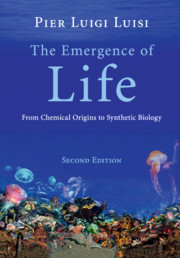Book contents
- Frontmatter
- Contents
- Acknowledgments
- Introduction
- Part I Approaches to the origin of life
- Part II What is life? The bio-logics of cellular life
- Part III Order and organization in biological systems
- Part IV The world of vesicles
- 11 The various types of surfactant aggregates
- 12 Vesicle reactivity and transformations
- 13 Biochemistry and molecular biology in vesicles
- Part V Towards the synthetic biology of minimal cells
- As a way of conclusion
- Appendix The open questions about the origin of life
- References
- Names index
- Subject index
13 - Biochemistry and molecular biology in vesicles
from Part IV - The world of vesicles
Published online by Cambridge University Press: 05 September 2016
- Frontmatter
- Contents
- Acknowledgments
- Introduction
- Part I Approaches to the origin of life
- Part II What is life? The bio-logics of cellular life
- Part III Order and organization in biological systems
- Part IV The world of vesicles
- 11 The various types of surfactant aggregates
- 12 Vesicle reactivity and transformations
- 13 Biochemistry and molecular biology in vesicles
- Part V Towards the synthetic biology of minimal cells
- As a way of conclusion
- Appendix The open questions about the origin of life
- References
- Names index
- Subject index
Summary
Introduction
We have seen in the previous chapter that liposomes are suitable models for biological cells, or, more precisely, for the shell of biological cells. In order to bear some resemblance with biological cells, biochemical compounds must be present in the interior. This is the large field of entrapment of solutes in vesicles, focusing particularly on biopolymers such as proteins and nucleic acids. In the previous chapter, we have described the entrapment of molecules in micelles, reverse and/or aqueous, and in this case, the entrapment is made possible by the dynamics of micelles, as they are open systems, which break and reform continuously. We know already that the case of vesicles is very different, as vesicles are generally not very permeable. Let us then see, first, how the entrapment can be carried out.
The entrapment of solutes in vesicles
Only occasionally, depending upon the chemical nature of the solute and/or the lipid surfactant, some restricted and selective permeability is observed. In the experiment illustrated in Figure 13.1, an apolar molecule is capable of permeating inside, where it reacts with phosphate ions by the opening of the ring: the product, being now polar, is trapped inside. In this case, although the permeability is very low, the irreversible chemical transformation of the reagent inside the liposomes drives the incorporation process.
Since permeation does not work for enzymes and other macromolecules, these have to be incorporated during the formation of vesicles. A schematic illustration is shown in Figure 13.2, which shows a classic way to incorporate a macromolecule, an enzyme in this case, inside the liposomes: one starts from a film of the water-insoluble surfactant, e.g. oleate or a phospholipid like POPC, while the solution contains the enzyme to be entrapped. The next step is a robust vortexing, which sends out lamellae of the lipid in water, which then form the spherically closed liposomes. In the process of closure, the liposome entraps mechanically part of the solute molecules. In this particular experiment, the enzyme is capable of polymerizing ADP into Poly-A, and ADP is left permeate inside the liposomes in a very slow and not very efficient process – but eventually enough ADP permeates inside to bring about the synthesis of the polynucleotides. In this case, as in the previous example, the macromolecule cannot leak out, so it accumulates inside.
- Type
- Chapter
- Information
- The Emergence of LifeFrom Chemical Origins to Synthetic Biology, pp. 319 - 332Publisher: Cambridge University PressPrint publication year: 2016



